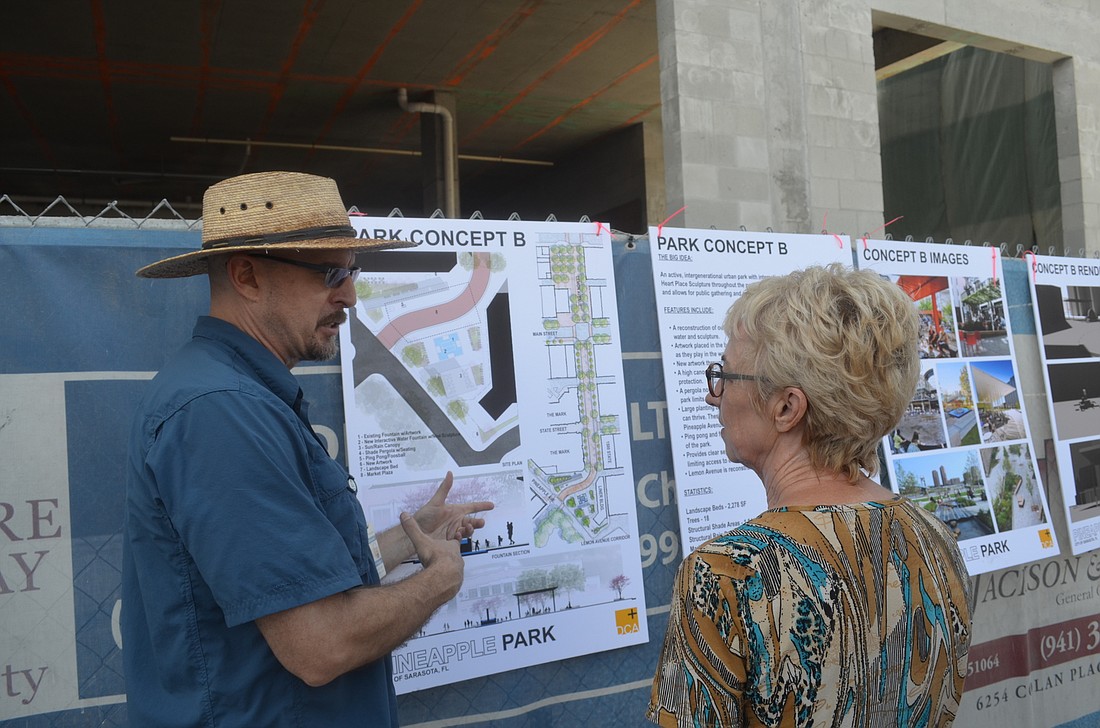- May 1, 2025
-
-
Loading

Loading

For residents like Barbara Campo, the idea of doing anything to alter the appearance of the mermaid fountain in Pineapple Park is sacrilegious.
They’ve heard the rationale from the city, as staff prepares a master plan to redesign the 6,600-square-foot downtown park at Pineapple and Lemon avenues. The fountain wasn’t designed to fit the current footprint of the park, which has evolved since the city installed the artwork in 1994.
Any redesign wouldn’t touch the centerpiece of the fountain, a semicircular panel with a mermaid on one side and a tree on the other. The goal would be to tear down barriers to appreciating the artwork in the fountain — remove the walls that surround the fountain’s pools, and let visitors get a better glimpse at the tile decorations that line the basin.
Campo has been at the presentations where city staff and a consultant have shared this line of thinking and more. She’s not moved.
“It is a work of art,” Campo said. “Are they going to take the hat off the sailor next?”
As the city develops a master plan for Pineapple Park, it will need to address concerns from Campo and others who prioritize the preservation of a piece of Sarasota’s history as-is.
On Saturday, the city set up a booth at the Sarasota Farmers Market and presented two options for a redesigned Pineapple Park, developed with the assistance of Tampa-based planner David Conner. Concept A would maintain the fountain as-is; Concept B would remove the exterior of the fountain and place the outer pools underground, so visitors could walk up to the center of the structure.
There are other differences between the two ideas. Concept A creates additional shade using canopy trees, and Concept B would add canopy structures and work to create a more active environment in the park.
Todd Kucharski, the city’s public works general manager, said he’s heard positive feedback regarding both options — including residents who favor one concept, but also like elements from the other. But the idea of revamping the fountain has generated the most outspoken opposition.
Kucharski said people became more receptive to the idea as he and Conner walked them through it. He thinks there are misconceptions about the city’s plan for the park. Officials want to preserve and enhance it, and they see the fountain as a vital part of Pineapple Park’s future.
“In both concepts, the centerpiece is the fountain,” Kucharski said.
Some residents are wary of the city’s intentions. This fear ties into the 2016 decision to sell a 5,049-square-foot piece of city-owned property directly adjacent to the park. Advocates for enhancing the park, including Campo, said the sale represented a giveaway of public parkland. They fear a restaurant tenant in the planned two-story building on that property will dominate the park in the future.
The city’s decision to pursue a master plan for Pineapple Park was a direct response to residents concerned about the decline of a valuable downtown park. If residents still suspect a nefarious motive on the part of the city, Conner said he’s had no outside sources influencing his planning recommendations.
“I have spoken with nobody from the businesses,” Conner said. “The city has told me nothing.”
One person who’s not steadfastly opposed to the idea of redesigning the fountain is the artist who created it. Nancy Goodheart Matthews is appreciative that the city is working to enhance the fountain her artwork anchors. Although she understands the city’s line of thinking, she does worry any changes could harm the interior mechanics of the fountain.
“It’s a great theory,” Matthews said. “I’m just dubious about pulling it off.”
Conner, on the other hand, is confident either proposal would enhance Pineapple Park.
“I’m a fool if I propose a design that won’t work,” he said.
Kucharski and Conner plan to present their final recommendations to the City Commission this summer. Even if the city adopts a master plan for the park, there is no funding currently allocated for improvements, and a timeline for implementing the recommendations is unclear.
Whatever the ultimate decision is, staff said its recommendations would reflect the input of the public — which is why Kucharski is still asking residents to share their thoughts on the future of the park.
“Even if they’re negative comments, it’s positive feedback,” he said.